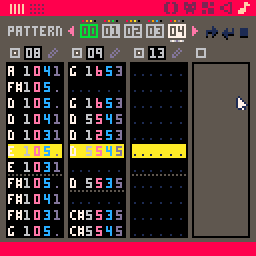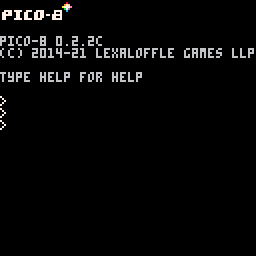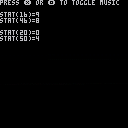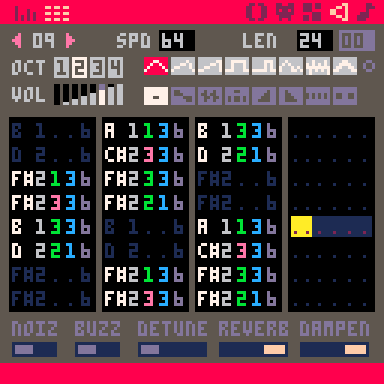This one turned out to be a relatively simple process:
- Select the "Organ" waveform.
- Make it as huge as possible.
The preview sounds terrible because it loops the vibrato weirdly, but when used as an actual instrument, the vibrato works as normal.
Wikipedia said that the Electric Piano 2 slot is often an FM piano patch, so I went in and tried to make something with a similar vibe:
This one ended up being really simple:
...but there's a couple tricks to using it in a way that feels violin-y.
First, you have to think about what exactly the violinist is doing at any given moment in order to navigate the notes they're being asked to play. For those who do not know violin performance well: the way a violin produces sound during normal play is by using a tensioned stick with hair coated in rosin attached to it - the aforementioned bow - to scrape along a string, imparting energy to the string that then causes it to vibrate and make sound. And, crucially, the bow is only so long, and can only be moved so slowly across the string ... so, as the violinist plays, they regularly have to stop and change direction.
Plus, the way a violin creates a specific note is not, as with a piano, by pressing a key, but by pressing a finger on a string to hold it against a fingerboard - there are no frets, and to change a note, the violinist has to move their finger to a new position.
So, in my demo of it:
...I use a lot of glides to represent places where a single stroke of the bow is being used to play multiple notes, and at the part at the end of the loop where the notes jump around a bunch, I chop off (sorta) the ends of the notes to give the impression of the gaps between notes from when the violinist had to move quickly.
Oh, and the second trick to it.
This SFX has built into it a point where the violinist runs out of bow and has to do another downstroke. (This is something I copied from the VS Chamber Orchestra sample I referenced when designing the note - it's not included in soundfonts like FluidR3.) If you're holding a note for a long time - 341 ticks, 2.83 seconds - the volume will drop off and there will be a moment like at the start of the SFX where the texture of the note roughens ... because the fictional violinist playing the note ran out of bow and had to do a second stroke. If you don't want that, you can change the loop points to stop before the repeat; if you do want that, you can adjust things to make it happen at the right tempo for your specific piece of music.
Steps to reproduce:
-
Create a custom SFX instrument.
-
Create an SFX using this instrument.
-
Add the latter SFX (but not the former) to a music pattern.
-
Select the pattern and copy.
- In a new PICO-8 cart, select a pattern and paste.
Expected behavior:
All necessary data to reproduce the original pattern should be transferred. (Notably, this occurs when pasting into the BBS.)
Observed behavior:
The SFX instrument is not copied, and only the SFX specifically included in the pattern are copied.
I'm gonna be honest: did this one next because I remembered my opening a soundfont in LMMS for the first time, browsing around, and going "wait, did that say Celeste?!"
(It did, but it's a case of shared etymology - it means the heavens. Or the sky.)
In keeping with the real-world version, this is a transposing instrument - plays an octave above the note entered. There is some artifacting on D#6, however.
This is a duplicate of this earlier piano SFX as far as the midilib project is concerned, but I wanted to share my attempt at replicating ... I think the sample I was referencing was an upright piano? As best as I could.
As with the others, this is free to use, although credit is appreciated; the manual entry on custom SFX instruments should explain how to use it.
No cart preview right now, but posting the SFX so people can use it: my latest best shot at a xylophone sound:
Free to use, credit appreciated; manual section on SFX instruments is here if it's not something you're familiar with.
So, PICO-8's built-in tracker has a startling amount of customization, but it can be kinda tricky actually making a custom SFX instrument when you want one - so a few of us on the Discord, me and @jo560hs and @bikibird, were thinking it might be interesting to look at the list of General Midi 1 instruments as a shopping list and see how many we can knock off.
And as a bonus, if we can complete the list, @jo560hs was talking about possibly making an sf2 soundfont for folks who like playing with those.
So, if you wanna jump in and add stuff to the catalog, the guidelines we decided on for convenience of people hunting down instruments afterwards are these:
- tag the post with
midilib - use a subject line of the format
midi [number] [name] - (ideally, each instrument should be posted in its own thread, so specific ones can be found more easily)
- embed your SFX there so people can hear it and copy it
- let folks know if you have any special requirements (I generally assume something akin to CC-BY, where people can use them freely if they credit you, but let us know!)
As people create more instruments, we'll try to look in the midilib tag and update everyone on what people have been doing, so folks who feel like doing whatever can see what's missing.
I've made a text file with a list of all the GM-1 instruments and their numbers - feel free to ask questions, promote your threads, and so on here.
Clarifying note about duplicates
Quick heads-up, because it seems to have been the source of a little confusion: yes, we do want to complete the list of SFX ... but even when people have already made SFX for a particular MIDI patch, please share your versions! I can tell you right now: I have eight different pianos downloaded to my hard drive that I can use as instruments in LMMS, plus four more in each of the two big sf2 soundfonts I downloaded, plus a bunch of presets for LMMS's built-in synths, plus all the other soundfonts I have ... and I have zero regrets. Just as much as we want this project to create a PICO-8 sf2 soundfont for producers to play with, we want this project to create a library of sounds for PICO-8 composers to play with. And variety is great because it lets people choose the perfect sound for their tracks.
So, please, post duplicates when you have them. Having more options is terrific.
About channel count and SFX count
For this project, our focus is on single-channel instruments. Those tend to be the most useful, and you can do a lot with a single SFX instrument on a single channel.
With the addition of the waveform mode, however, a single-channel SFX instrument can use multiple SFX instrument slots: one for the instrument, one or more for the waveforms. The unmarked instruments on this page all use a single SFX; any instruments that use multiple will be marked with how many they require.
Compilations of instruments as of 2023-11-05
Gmlib by wasiknighit is a complete (!) 128-instrument collection, divided into sixteen carts with built-in utility to preview or copy any SFX.
Individual instruments as of 2023-03-16
For anyone who wants it, an SFX imitating an electric guitar with overdrive:
Free to use, credit appreciated.
(If you are not already familiar, the manual has a brief explanation of how custom SFX instruments work.)
A group of us on the Discord were talking about how it'd be useful it'd be to have a big library of SFX instruments, so here's one I made a while ago to act as a ragtime piano:
Free to use, credit appreciated.
(If you are not already familiar, the manual has a brief explanation of how custom SFX instruments work.)
So, I'm working on a toy musical keyboard program, and I want to use SDL scancodes to detect which keys are being held - but I know that PICO-8 will pause if you hit the "P" key (whatever key that happens to be in the user's keyboard layout). So I want to detect when a "P" input is being received and stop it...
...but my current code:
--interrupt pause on P
while stat(30) do
if stat(31)=="p" or "◆" then
--suppress pause
poke(0x5f30,1)
end
end |
only works for the initial press - when the key starts repeating, stat(30) doesn't detect the input but PICO-8 pauses anyway.
Any suggestions? I'd rather not interrupt all pause inputs - that makes things difficult for Splore users.
Edit: Apologies to @dw817, whose explanations I apparently completely failed to parse: in the changelog for 0.2.2b it is noted that holding the pause button will always bring up the hardware pause menu, even when pause would otherwise be suppressed. This rules out any solution that involves the player holding down P that I can implement as cart programmer. (Shoutout to @cubee's description of a related bug which cued me in.)
I was updating a cart I was working on to use stat 46-56 instead of 16-26 and noticed that new bugs were introduced in the change. It looks like stat(16) updates immediately when a music() command is called, but stat(46) will sometimes show an erroneous value (e.g. -1) on the frame of the update.
Something I noticed today, browsing the PICO-8 forums on my iPhone 6: when I opened the Tell me about how you compose music thread, it would always crash the browser. Safari and Chrome would report that the tab had repeated errors, Opera would crash out entirely.
I'm guessing here when I suggest the embedded SFX music player is related to this, but I wonder if all the scripts are overloading the limitations of the device. Granted, this is a device that will sometimes struggle to run a PICO-8 cart at all, but it makes me wonder if some kind of click-to-activate option for SFX previews might be worth implementing.
Edit: It seems like this has been largely addressed by the new SFX preview system; closing.

There seems to be some kind of flaw on my system when playing music via the music pattern editor: it'll start playing normally, with the display scrolling, but despite my making no input with mouse, keyboard, or controller, it will abruptly stop scrolling and leave the cursor behind.
My first thought was that perhaps the active SFX in the SFX editor had started, but that wasn't the case in any of my tests. There's no obvious pattern to it - it's not after a fixed duration, after a fixed number of patterns, or after a specific pattern appears - but in each of the files I tried, it stopped on the same places in two separate tests.
The music continues playing as normal and correctly - it's as if, at an unpredictable point, PICO-8 decided I clicked on the SFX or the cursor or something to edit the current SFX.
Edit: I posted below that this seems to happen when the SFX in the selected channel changes from one pattern to the next; doing a quick test on 0.2.4, I didn't see it happen there. It looks like this may have been introduced in 0.2.4b.
Edit: Fixed in 0.2.4c!
This was an exercise I was doing in transcribing music from sheet music - in this case, the first Gymnopédies from Erik Satie's 3 Gymnopédies - and it actually turned out to contain a really interesting little technical challenge.
There's more polish I could and probably should do of this - I have twenty-five empty SFX to work with - but I'm happy with it. It was a really good exercise.
So, using PICO-8 with a US QWERTY keyboard (Wikimedia Commons image link), there's a kind of virtual music-keyboard embedded in it when you're editing SFX, with the bottom row from Z to M being the white keys of the octave below the one selected and the top row from Q to P being the white keys of the octave and a third above, and the black keys being on the lines above their adjacent white keys. C1 = z, C#1 = s, D1 = x, and so on.
For people using PICO-8 with other keyboard layouts, in the default keybindings, is this physical arrangement the same, or are the key names the same instead? Or some other situation?
As of 0.2.3, if you want to export a music composition in the tracker at the PICO-8 command line, the length of export caps at 32768 music ticks, or about four minutes and thirty-two seconds. To export something longer requires doing it in real time, be that five, ten, or seventy minutes, which is a pain and is slow.
Other exporters - sprite sheet, web application, binary - have flags to change how the export works; would it be possible to do something similar with the music/SFX exporter? Number of patterns played (or number of repeats, for a looping SFX) would seem the most intuitive for the end user, and (unlike music ticks) would involve numbers of a reasonable size, but I'm not attached to any specific solution.
Weird tiny bug I've noticed in 0.2.2c on Windows 7: if, either when PICO-8 is booting or rebooting, I hit Ctrl+M to toggle mute before the commandline appears, the M appears at the commandline after boot.

In versions of PICO-8 prior to 0.2.2, and according to the manual:
SFX instruments are only retriggered when the pitch changes, or the previous note has zero volume. This is useful for instruments that change more slowly over time. For example: a bell that gradually fades out. To invert this behaviour, effect 3 (normally 'drop') can be used when triggering the note. All other effect values have their usual meaning when triggering SFX instruments. |
However, in version 0.2.2, these SFX also retrigger when they have exceeded their total length.
The SFX up top demonstrates this: in 0.2.1b,
- SFX 03 plays a single 16-tick note three times, 128 ticks apart, and
- SFX 04 plays eight 16-tick notes at equal 32-tick intervals;
but in 0.2.2c,
- SFX 03 plays a 64-tick note, two 16-tick notes, and then two 16-tick notes, and
- SFX 04 plays eight 16-tick notes at a syncopated rhythm, alternating 48 and 16 ticks.
This will break some pre-0.2.2 compositions.
p.s. Slight edit correction: the manual is also incorrect in the opposite direction, because custom SFX instruments do not retrigger if the previous note has zero volume but uses the same pitch and instrument.
This is the most minor thing ever, but the manual currently says under stat x
20..23 Note number (0..31) on channel 0..3 |
...but if the LEN of the SFX or LOOP endpoint of the SFX is greater than 32 and the SFX plays that long, then stat(20..23) will display numbers greater than 32 just fine.
I don't know if this is worth fixing, but something like "(normally 0..31)" would be technically accurate and still probably convey the desired information.
View Older Posts







 3 comments
3 comments



